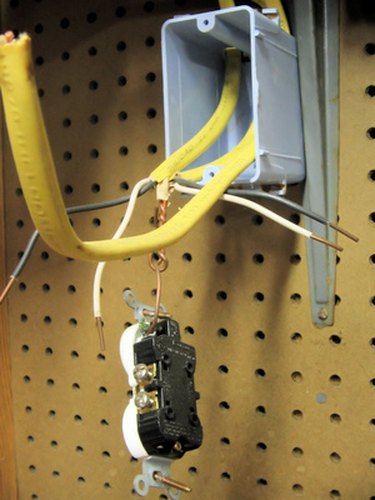
The quick answer to the questionis, "more than you think." Of course there's no one answer which will peg the amount of wire needed to electrify a house. Obviously a 1200-square-foot, two-bedroom bungalow won't require as much wire as a multi-room mansion.
But there are some facts you can use to make a reasonable estimate of the amount of wire needed for the home you are planning.
Video of the Day
Video of the Day
Nomenclature
Just as Kleenex is often used to describe other brands of tissue, ROMEX® is a brand name of electrical cable now owned by Southwire, Inc. It's more proper to call non-ROMEX® brand cable NM or NMD cable which stands for non-metallic or non-metalic, dry. NMD (ROMEX®) is designed for use in homes or other places where it will be routed through walls, along rafters or floor joists and other weatherproof places where it is secured away from access by people doing their everyday activities.
Specifications
ROMEX® and other NMD cable consists of two or three individual strands of insulated wire along with one non-insulated wire, all encased in a plastic sheath. The non-insulated wire is always a ground wire. Two-wire with ground is used to wire 120 volt circuits. NMD used for 220 volt circuits contains three insulated wires along with the uninsulated ground wire.
Wire Gauge
Most homes are wired with a mix of 12 gauge and 14 gauge NMD 120 volt circuits. A few heavy duty appliances such as air conditioners, electric furnaces or electric water heaters may require heavier gauge wires, are usually 220 volts and are always wired as a dedicated circuit, meaning the furnace has it's own circuit breaker in the electrical panel, the A/C it's own. Circuits running to kitchens, garages and utility rooms which are likely places for multiple electrical appliances to be operated are wired with 12 gauge NMD and connected to 20 amp circuit breakers. Circuits running to other rooms where electrical use is less are usually wired with lighter, 14 gauge NMD and connected to a 15 amp circuit breaker. If in doubt what you will require, add up the wattage of the lights and appliances you plan to operate on a circuit then divide by the volts. The quotient is the number of amperes the circuit will handle. A circuit powering a pair of 100 watt lights, a computer (225 watts) and a vacuum cleaner (550 watts) uses 875 watts divided by 120 volts or slightly more than 7 amperes, so 14 gauge NMD on a 15 amp circuit breaker will work just fine.
Measuring
With these ideas in mind, get out the plans for the house, or get out your tape measure if the house is studded up and ready for the wiring to be installed. Lay out the circuits (the outlets and fixtures you want connected together) and the routes the wires will take from the circuit breaker panel, under the floors or through the attic and walls to the outlets, the light fixtures and switches. Add up the results and you'll know how much wire you'll need. Then buy an extra 250 foot roll of each size. Remember: you'll need more than you think. And you can always return it for a refund.